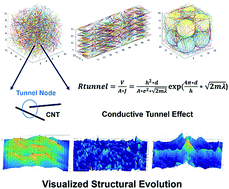Visualized simulation for the nanostructure design of flexible strain sensors: from a numerical model to experimental verification†
Abstract
Reconciliation of the conflict between sensitivity and working range of strain sensors is highly desirable and still remains a great challenge due to the lack of efficient evaluation systems for nanostructure design. Herein, we present a visualized digital analysis based on the nodal statistics method to analyze spatial nanostructures and their evolution under tensile strain. Unlike the widely used experimental evaluation and numerical simulation, the visualized analysis method established herein reveals the effect of structural evolution on the sensing performance in an intuitive way while exhibiting high analytical efficiency and low resource consumption. Guided by the visualized analysis, nanocomposites with a desired balance between sensitivity and working range were achieved. This study not only promotes the development of wearable flexible sensors via the visualized digital analysis-guided manufacturing, but also provides a general approach for the preparation of functional electronic devices including electromagnetic shielding materials, and electric actuators.

- This article is part of the themed collection: 2019 Materials Horizons Most Popular Articles


 Please wait while we load your content...
Please wait while we load your content...